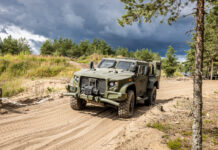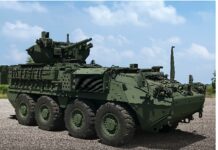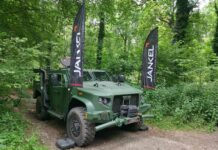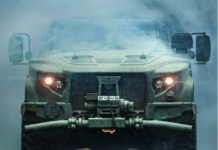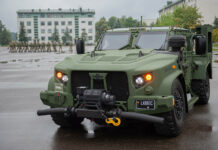On 26 June, the US Army announced that GM Defense LLC would receive the contract to produce, field and sustain the new Infantry Squad Vehicle (ISV). General Motors beat out two other contenders in the final phase of the ISV competition, Oshkosh Defense and SAIC.
Prototypes from all three firms had been evaluated from November 2019 through January 2020, including operational and static testing at Fort Bragg, North Carolina by units of the 82nd Airborne Division.
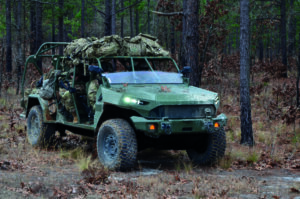
The ISV will be supplied to airborne and airmobile Infantry Brigade Combat Teams (IBCTs). According to an Army statement, the unarmoured lightweight vehicle will enhance mobility and flexibility by moving soldiers and their equipment quickly over complex, difficult or restrictive cross-country terrain. This will allow soldiers to approach their operational targets with less fatigue and greater readiness while enhancing survivability, the statement stressed. Procurement of the ISV is also largely a response to the dense air defence networks US forces can expect to encounter in future wars. The vehicle will permit C-17 or C-130 aircraft to drop paratroops further from their objective, in sufficient distance from enemy air defences and perhaps even undetected by enemy sensors.
- The basic performance profile of the ISV, as required by the Army going into the competition, includes:
- Nine-man squad carrying capability, to ensure operational unit cohesion;
- Payload of 3,200 pounds (1,455 kg);
- External sling load by a UH-60 BLACK HAWK helicopter;
- Internal load/external lift by CH-47 CHINOOK helicopter;
- Low-velocity air drop by fixed-wing C-130 or C-17 transport aircraft;
- Exceptional mobility over all terrains.
General Motors Design
GM’s design for the ISV is based on the commercial Chevrolet COLORADO ZR2. Although a mid-sized civilian pickup truck, the ZR2 has proven itself in near-military-quality off-road racing and rock crawling events. GM has emphasised its performance in the Best of the Desert race series, where the COLORADO is one of only four vehicles (out of 434 competitors) to complete eleven consecutive races. According to GM, ZR2 vehicles have completed, in total, more than 10,000 miles of highly-challenging off-road and desert racing.

The ISV will draw 90% of its components from commercial-off-the-shelf Chevrolet Performance brand parts used on the COLORADO and BISON variants of the ZR2. These include: long-travel rear leaf springs; the nitrogen-charged, hydraulic front jounce shock system; high-angle upper control arms; a steel driveshaft; locking front and rear differentials; ball-spline half shafts. Many of these components were specifically designed for the needs of high-performance off-road vehicles. Major vehicle systems including the engine, transmission, and steering are electronically controlled. Particularly important elements of the General Motors ISV design include:
Roll-Over Protection System (ROPS): The open-topped passenger and cargo section is protected by a roll-bar framework made of lightweight but high-strength 4130 chromoly alloy. This ROPS cage can be collapsed and stored when the ISV is internally carried via CH-47. The protective framework can also be customised to accommodate specific passenger or cargo payload requirements.
Propulsion: The ISV will be powered by a 186-horsepower, 2.8L DURAMAX turbo-diesel engine, electronically assisted power steering and six-speed automatic transmission. According to GM’s ISV product sheet, the performance tune of the DURAMAX 2.8L engine will produce significantly more power than the ZR2’s engine, which itself delivers 186 horsepower and 369 pound-foot of torque.
Dynamic Suspension: Long-travel Multimatic Dynamic Suspensions Spool Valve (DSSV) dampers are designed to minimise stress on passengers and to maximise driver control over the vehicle. The precision spool valve technology enhances performance during both on-road and off-road operations. As described by GM, when wheel travel moves outside normal road operating range, a third spool valve specifically tuned to provide extra damping comes into play, helping to maintain control during high-displacement wheel movement and high-impact compression cycles.
Underbody Protection: Several underbody skid plates are in place to protect critical components including the engine, suspension, drive train and fuel tank.
The final design for the ISV incorporates soldier feedback from infantry personnel who evaluated the competing prototypes in static and operational testing, as well as real-world lessons from recent overseas missions. Every effort was made to maximise not only performance but also simplify operation. The lack of doors or side panels permits near-instantaneous boarding and egress by armed soldiers. The ISV’s sloping hood optimises the driver’s forward visibility up to within five meters of the vehicle’s front. The single-piece hood and fender design was chosen to ease access to the engine and facilitate maintenance.
Dimensions and performance characteristics include: Overall length, width and height of 5.26 metres by 2.08 metres by 1.88 metres. Curb weight is below the Army’s maximum threshold of 2,272 kg. Mounting 89 centimetre diameter tires, the ISV has a minimum ground clearance of 35 centimetres. Approach, breakover and departure angles as cited by GM are 46.1, 26.4 and 42 degrees, respectively.
Vehicle design, development and construction rest in the hands of General Motors Defense. In January 2020, GM Defense teamed with the British engineering firm Ricardo plc to provide support with product logistics and fielding requirements. Ricardo is expected to develop and provide integrated logistics solutions and life cycle sustainment for operational vehicles, areas in which the firm enjoys considerable experience. This is likely to include development of technical and training manuals for operators and maintenance personnel.
Operational in 2021
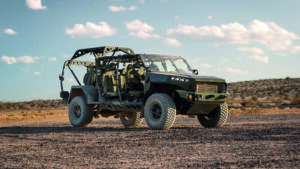
The procurement programme and competition are managed by the US Army’s Maneuver Capabilities Development and Integration Directorate (CDID) at Fort Benning, Georgia. Due to the perceived urgency of the capability set, the Army opted for an accelerated testing and procurement procedure. “Using an innovative acquisition approach through an Other Transaction Authority – a flexible, collaborative tool designed to speed acquisition and modernisation – the ISV team awarded the production contract for this capability in 16 months. Using normal acquisition processes, it could have taken as many as 36 months,” said Timothy G. Goddette, the Army’s programme executive officer for Combat Support and Combat Service Support, or PEO CS&CSS.
The initial phase of the procurement contract calls for GM to deliver eight ISVs for extensive testing at Aberdeen Proving Grounds, Maryland by October. Steve Herrick, the Army’s product lead for Ground Mobility Vehicles at PEO CS&CSS, stated that the production qualification testing will address the vehicles’ ability to meet the performance specifications in areas not previously tested, while simultaneously enhancing confidence in areas already tested. He continued to explain that the ISV will also undergo transportability certification, including low-velocity air drop and helicopter sling loading. The Army will conduct initial operational test and evaluation in Summer and Autumn of 2021.
The 1st Brigade, 82nd Airborne Division will be the first unit operationally equipped with the ISV; according to Steve Herrick, deliveries are expected to begin approximately eight months after contract award, which would be circa February 2021. The current contract covers acquisition of 649 vehicles, at an overall programme cost of US$214.3M; this figure includes installation kits, ancillary hardware and logistical support. Completion of deliveries under this contract is expected by June 2028. The Army has announced a comprehensive acquisition objective of 2,065 vehicles. No date for award of a follow-on procurement contract has been determined.
Sidney E. Dean





